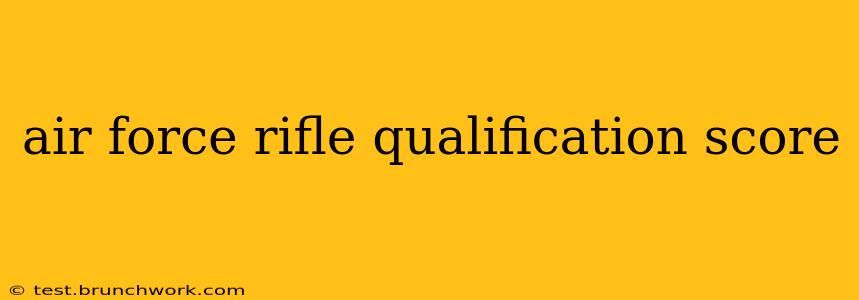The Air Force places a high value on marksmanship proficiency, recognizing its importance in various operational scenarios. This guide provides a comprehensive overview of Air Force rifle qualification scores, the standards required, and what those scores mean for airmen. Understanding this system is crucial for both airmen striving for excellence and those simply curious about the process.
Understanding Air Force Rifle Qualification
Air Force rifle qualification is a standardized test designed to evaluate an airman's ability to accurately and effectively engage targets with a service rifle. The qualification process involves a series of shooting exercises at varying distances and under different conditions, simulating real-world scenarios. The scores achieved directly impact an airman's performance evaluations and potential career advancement opportunities. These qualifications aren't just about hitting targets; they demonstrate discipline, precision, and the ability to perform under pressure – essential attributes for military personnel.
Types of Rifle Qualification
The Air Force utilizes different rifle qualification courses depending on the specific weapon system and the airman's role. While the exact details may vary, the common thread is a rigorous evaluation of marksmanship skills. These qualifications typically involve various firing positions (prone, kneeling, standing) and different target types, assessing adaptability and proficiency under varied circumstances. The specific types of qualifications and their scoring systems will be detailed to the airmen during their training.
Decoding the Air Force Rifle Qualification Scores
Air Force rifle qualification scores are typically categorized into several levels, each representing a different level of proficiency. While the exact numerical scoring system isn't publicly released for security reasons, the general categories are widely understood. These categories reflect the level of accuracy and efficiency demonstrated during the qualification process. The higher the score, the greater the proficiency.
Expert Marksman (or equivalent):
This is the highest level of achievement, representing exceptional marksmanship skills and consistent accuracy across all firing positions and target types. Achieving this level often requires extensive training and practice.
Sharpshooter (or equivalent):
This indicates a high level of proficiency, demonstrating consistent accuracy and skill in most firing scenarios. Airmen achieving this level are considered highly competent in marksmanship.
Marksman (or equivalent):
This denotes a satisfactory level of marksmanship proficiency, meeting the minimum requirements for qualification. While it demonstrates competency, there's room for improvement.
Unqualified:
This indicates that the airman did not meet the minimum standards for qualification and requires further training to improve their marksmanship skills.
Factors Affecting Rifle Qualification Scores
Several factors can influence an airman's rifle qualification score. These include:
- Training and Practice: Consistent and dedicated training is crucial for achieving high scores.
- Weapon Familiarity: Proficiency with the specific rifle used during qualification is essential.
- Physical Fitness: Physical condition impacts stability and accuracy during firing.
- Mental Focus: Maintaining focus and composure under pressure significantly contributes to performance.
- Environmental Conditions: Weather conditions such as wind and temperature can affect accuracy.
The Importance of Rifle Qualification in the Air Force
Maintaining a high level of rifle proficiency is not merely a matter of scoring well; it directly impacts mission readiness and overall operational effectiveness. For airmen who might find themselves in situations requiring the use of a firearm, their training and qualification are paramount to mission success and the safety of themselves and their comrades. The skills learned and honed during qualification translate into improved situational awareness and decision-making abilities.
Note: Specific scoring systems and qualification standards are subject to change and are not publicly released in full detail. This information is for general understanding and should not be considered an official guide. Always refer to official Air Force documentation for the most up-to-date and accurate information.
